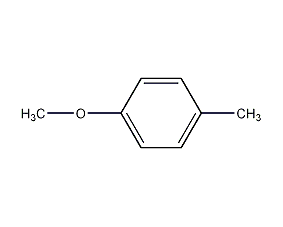
Structural formula
| Business number | 02R0 |
|---|---|
| Molecular formula | C8H10O |
| Molecular weight | 122.16 |
| label |
4-methylanisole, p-methylanisole, 1-methoxy-4-methylbenzene, p-Methylanisole, p-Cresyl methyl ether, 1-Methoxy-4-methylbenzene, Edible spices, Ether solvents, aromatic compounds |
Numbering system
CAS number:104-93-8
MDL number:MFCD00008413
EINECS number:203-253-7
RTECS number:BZ8780000
BRN number:1237336
PubChem number:24882038
Physical property data
1. Properties: Colorless liquid, with a slight ether smell, and a ylang-ylang oil and violet-like aroma.
2. Relative density (g/mL, 20/4℃): 0.969
3. Melting point (ºC): -32.1
4. Boiling point ( ºC, normal pressure): 176.7
5. Refractive index(n20D): 1.5132
6. Flash point (ºC): 59
7. Solubility: Insoluble in water, miscible with various organic solvents such as alcohol and ether.
8. Refractive index at room temperature (n25): 1.5094
9. Relative density (25℃, 4℃): 0.961832.6
10. Critical temperature (ºC): 392.85
Toxicological data
1. Skin/eye irritation: Standard Dresser test: rabbit skin contact, 500mg/24 HREACTION SEVERITY, moderate reaction; 2. Acute toxicity: rat oral LD50: 1920mg/kg; mouse peritoneal cavity LD: >500mg/ kg; Rabbit skin contact LD50: >5mg/kg; 3. Other multiple dose toxicity: Rat oral TDLo: 3360mg/kg/4W-I;
Acute toxicity:
Oral LD50 1920mg/ kg(rat)
Skin LD50 >5mg/kg(rbt)
Skin irritation modetate 500mg/24H(rbt)
Main irritating effects:
On skin: Irritates skin and mucous membranes.
On eyes: Irritation effects
Sensitization: No known sensitizing effects.
Ecological data
General remarks
Water hazard level 1 (German regulations) (self-assessment via list) This substance is slightly hazardous to water.
Do not allow dilute or large quantities of product to come into contact with groundwater, waterways or sewage systems.
Do not discharge materials into the surrounding environment without government permission.
moleculeStructured data
1. Molar refractive index: 37.75
2. Molar volume (cm3/mol): 129.7
3. Isotonic specific volume (90.2K ): 301.5
4. Surface tension (dyne/cm): 29.2
5. Dielectric constant:
6. Dipole moment (10-24cm3):
7. Polarizability: 14.96
Compute chemical data
1. Reference value for hydrophobic parameter calculation (XlogP): None
2. Number of hydrogen bond donors: 0
3. Number of hydrogen bond acceptors: 1
4. Number of rotatable chemical bonds: 1
5. Number of tautomers: none
6. Topological molecule polar surface area 9.2
7. Number of heavy atoms: 9
8. Surface charge: 0
9. Complexity: 72.6
10. Number of isotope atoms: 0
11. Determine the number of atomic stereocenters: 0
12. Uncertain number of atomic stereocenters: 0
13. Determine the number of chemical bond stereocenters: 0
14. Number of uncertain chemical bond stereocenters: 0
15. Number of covalent bond units: 1
Properties and stability
1. Avoid contact with oxidants. It is a flammable liquid. Not volatile. In case of fire, foam fire extinguishing agent or carbon dioxide can be used to extinguish the fire. Chemical properties are similar to anisole. It does not decompose to weak acids and breaks the ether bond when reacting with aluminum trichloride, aluminum tribromide and antimony chloride.
2. Exist in smoke.
3. Naturally found in tomatoes, cheese, mustard, and ylang ylang oil.
Storage method
Store in a cool, ventilated warehouse. Keep away from fire, heat sources and anti-static. should be kept away from oxidizer, do not store together. Equipped with the appropriate variety and quantity of fire equipment. The storage area should be equipped with emergency release equipment and suitable containment materials.
Synthesis method
It is produced by the methylation reaction of p-cresol and dimethyl sulfate in the presence of sodium hydroxide. After the reaction, it is neutralized and washed, separated into layers, and distilled under reduced pressure to obtain the finished product. The process is similar to 2- methyl anisole.
Purpose
1. This product is an edible spice that is allowed to be used according to my country’s GB2760-86. Mainly used to prepare nut flavors such as walnuts and hazelnuts. It is also used to prepare artificial ylang-ylang, cananga, violet, daffodil and other flavors.
2. Commonly used in baked goods, soft candies, Frozen dairy products.

 微信扫一扫打赏
微信扫一扫打赏

